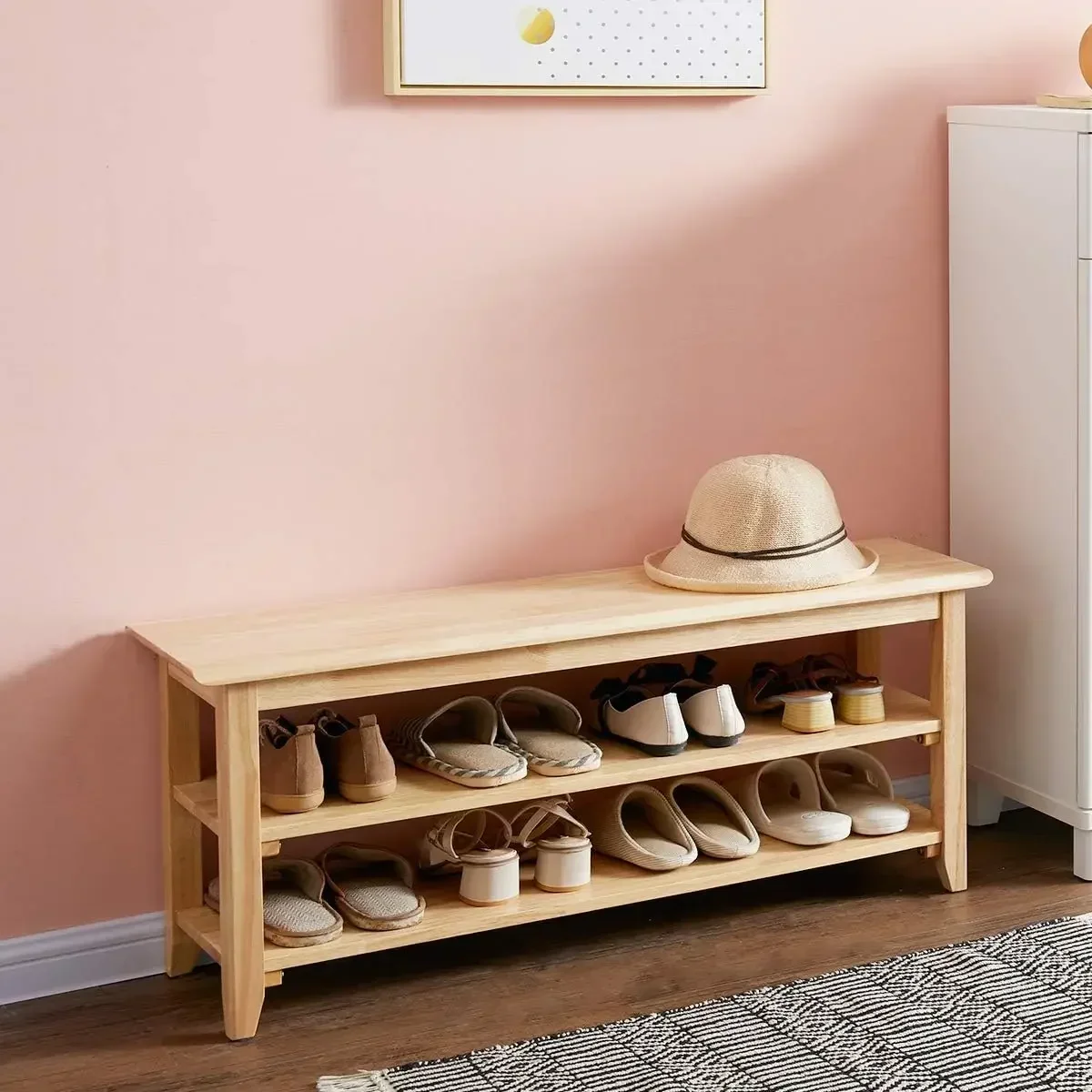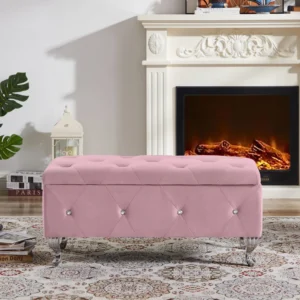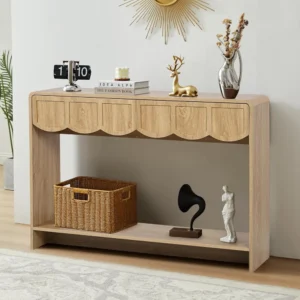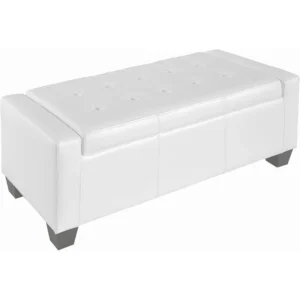Introduction: Transforming Tight Entryways with the Right Bench
Walking into a small entryway can feel like navigating a puzzle. In today’s homes where space comes at a premium—with the average apartment entryway measuring just 4-6 feet wide—making every inch count becomes essential. A thoughtfully selected bench can completely transform these tight spaces, offering both practicality and style where you need it most.
The beauty of an entryway bench lies in its dual personality: it’s not just a place to sit while removing shoes, but also a storage solution, organizational hub, and style statement all wrapped into one compact package. Even the tightest spaces can benefit from this versatile piece of furniture.
This guide will help you navigate the process of selecting and positioning the perfect bench for your unique spatial constraints, turning your cramped entryway into an efficient, welcoming transition between outdoors and home. With the right approach, even the smallest entryway can benefit from compact storage benches for small apartments that blend seamlessly with your home’s aesthetic while solving everyday organizational challenges.
Why Entryway Benches Are Perfect for Small Spaces
Entryway benches offer exceptional value in small spaces for several compelling reasons:
Multifunctionality: Unlike single-purpose furniture, benches serve multiple roles simultaneously—providing seating for removing shoes, storage for everyday items, and a display surface for decorative elements.
Space efficiency: Benches utilize vertical space rather than sprawling horizontally, making them ideal for narrow hallways and tight corners where floor space is limited.
Entry organization: They create a dedicated “landing zone” for daily essentials, preventing items from migrating throughout your home and creating clutter elsewhere.
Psychological transition: A well-designed entryway bench establishes a clear boundary between outside and inside, helping you mentally transition from public to private life when entering your home.
Design versatility: Available in countless configurations, you’ll find options ranging from ultra-slim models just 10 inches deep to corner units that maximize awkward spaces.
These benefits explain why apartment-friendly storage bench ideas have become increasingly popular among those looking to maximize limited square footage without sacrificing style or functionality. Even in spaces where every inch matters, a thoughtfully selected bench can transform your entryway experience.
Essential Measurements: Finding the Perfect Fit
Finding a bench that fits your specific entryway requires careful measurement and planning before you shop:
Measure available width: Determine the maximum horizontal space available, accounting for any obstacles like radiators or light switches. Most small-space entryway benches range from 24-36 inches (61-91 cm) wide.
Assess depth constraints: Measure from the wall outward, keeping in mind that you’ll need at least 36 inches (91 cm) of clear pathway for comfortable movement. Compact benches typically range from 12-15 inches (30-38 cm) deep.
Consider optimal height: The standard height for comfortable seating is between 17-19 inches (43-48 cm) from the floor.
Account for door clearance: Ensure your bench won’t interfere with door swing. Mark the door’s path with tape if necessary to visualize its full range.
Evaluate traffic flow: Will multiple people use the entryway simultaneously? Ensure there’s enough space for comfortable movement.
Visualize before buying: Use painter’s tape to outline the bench dimensions on your floor. Live with this outline for a few days to confirm the size works with your daily routine.
Understanding these key measurements is fundamental when choosing the perfect bench for a tight hallway. Taking the time to accurately measure and visualize the space can prevent costly mistakes and ensure your bench enhances rather than hinders your entryway’s functionality.
Space-Saving Bench Styles for Compact Entryways
When space is limited, the bench style you select can dramatically impact both functionality and visual spaciousness:
Narrow Console Benches: These slim-profile options typically measure just 10-12 inches (25-30 cm) deep while maintaining standard seating width. Their minimal footprint makes them ideal for extremely narrow hallways where every inch of walking space matters.
Wall-Mounted/Floating Benches: By attaching directly to the wall without legs, these benches create an open feel by keeping floor space visible beneath. This style works particularly well in tiny entryways where visual lightness helps prevent a cramped feeling.
Corner Benches: L-shaped designs transform often unused corner spaces into functional seating and storage areas. These benches follow the contours of your walls, utilizing spaces that would otherwise go wasted.
Nesting or Expandable Benches: These adaptable options include pull-out sections or nesting components that can be expanded when needed and tucked away when not in use—perfect for homes with occasional guests but limited everyday space.
Backless Benches: By eliminating the vertical back component, these streamlined options reduce visual bulk while maintaining full functionality, making the entire entryway feel more open.
Built-In Solutions: Custom-built benches can be designed to perfectly fit unusual spaces, including sloped ceilings, awkward corners, or spaces with existing architectural features.
For the slimmest spaces, our collection of narrow entryway bench options offers specialized solutions designed specifically for tight quarters, with some models measuring just 8-10 inches (20-25 cm) in depth while maintaining full functionality.
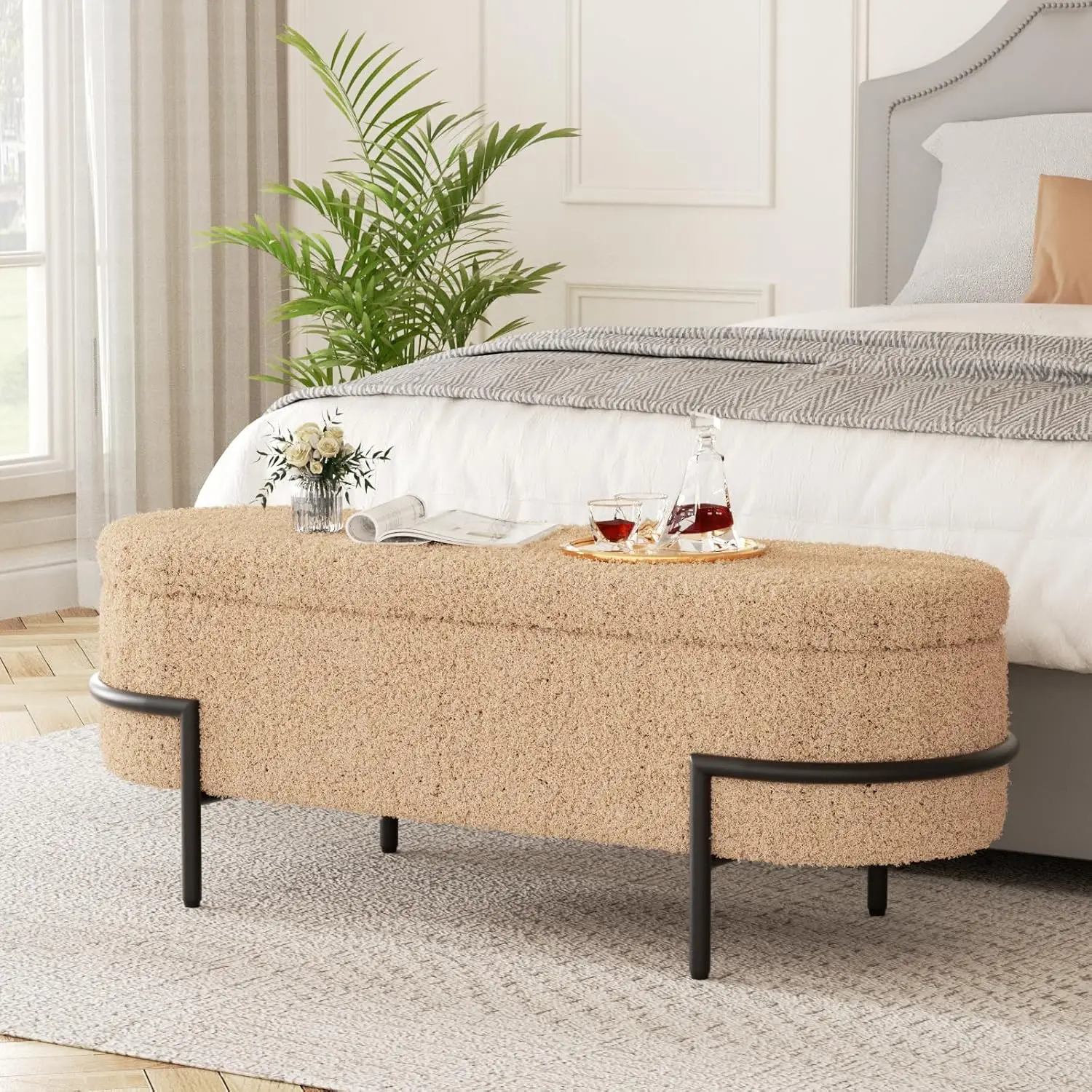
Maximizing Storage in Minimal Space
The true genius of entryway benches for small spaces lies in their storage capabilities that help contain clutter in limited square footage:
Hidden Compartments: Lift-top benches feature seats that raise to reveal spacious storage underneath—perfect for seasonal items, extra shoes, or rarely-used essentials. These designs maintain a clean visual appearance while concealing items that would otherwise create clutter.
Under-Bench Organization: Many compact benches incorporate shoe racks, pull-out baskets, or cubbies beneath the seating surface. A standard 30-inch (76 cm) bench with built-in shoe storage can typically accommodate 4-6 pairs of adult shoes—perfect for storing everyday footwear without visual clutter.
Drawer Systems: Slim pull-out drawers offer organized storage for small essentials like keys, mail, and gloves. Unlike open storage, drawers keep items hidden from view while maintaining easy accessibility.
Vertical Integration: The most efficient small-space solutions combine horizontal bench seating with vertical elements like wall hooks, overhead shelves, or attached cabinets—creating complete organization centers with minimal footprint.
Multipurpose Design: Look for benches that incorporate coat racks, umbrella stands, or mail slots to eliminate the need for separate pieces of furniture that would consume additional floor space.
Our entryway bench storage collection features options specifically designed to maximize organizational capacity while minimizing spatial requirements. Remember that in small spaces, choosing furniture with built-in storage functionality effectively reduces the need for additional organizational pieces.
Material and Style Selection for Small Spaces
The materials and design aesthetic you choose significantly impact how a bench performs in a small entryway:
Best Materials for Durability:
– Solid hardwoods (oak, maple, walnut) offer exceptional longevity but tend to be heavier
– Metal frames provide strength with visual lightness
– High-quality engineered wood offers durability at a more accessible price point
Visual Impact:
– Glass or acrylic components create an illusion of more space
– Open-frame designs with visible floor underneath feel less imposing
– Reflective surfaces help bounce light and visually expand the space
Style Considerations:
– Modern minimalist designs with clean lines reduce visual clutter
– Traditional pieces with tapered legs maintain classic appeal without overwhelming
– Industrial styles often incorporate smart storage solutions within metal frameworks
– Farmhouse benches bring warmth while offering practical simplicity
Color Strategy:
– Light colors (white, cream, light wood) visually recede, making spaces feel larger
– Dark colors create definition and can anchor a small space when used thoughtfully
– Consider matching your bench to wall color for a streamlined, cohesive look
When selecting materials, also consider practical concerns like moisture resistance, especially important in entryways where wet shoes and umbrellas are common. Innovative approaches to organizing small apartments with benches often balance these practical and aesthetic considerations, creating solutions that work beautifully even in the most compact spaces.
Strategic Placement: Where to Position Your Bench
The location of your bench can be just as important as its size and style in maximizing a small entryway:
Wall Alignment: In most small spaces, positioning your bench flush against the longest available wall creates the most efficient layout. This placement maintains a clear pathway while providing a stable backdrop for the piece.
Door Clearance: Always position your bench at least 2 feet (61 cm) away from any swinging door’s full range of motion. For entry doors that open inward, place the bench on the opposite wall or far enough away to prevent blocking the entryway.
Traffic Flow: Consider how people naturally move through the space. Avoid placements that create bottlenecks or force awkward navigation. The standard recommendation is maintaining a 36-inch (91 cm) clear pathway.
Light Considerations: Position your bench to benefit from natural light sources without blocking them. Avoid placing tall components where they might cast shadows over the entire entryway.
Visual Balance: In asymmetrical spaces, your bench can help create equilibrium. Use it to balance other architectural elements like stairs or built-in features.
Small Space Tricks: Place a mirror above your bench to instantly double the perceived space while creating a practical spot to check your appearance before leaving. Wall-mounted lighting flanking the mirror further enhances functionality without consuming valuable surface area.
Thoughtful placement transforms your bench from mere furniture into an integral part of your narrow entryway space organization. Even the most beautiful bench will fail to function properly if its placement interrupts the natural flow of your home’s entrance.
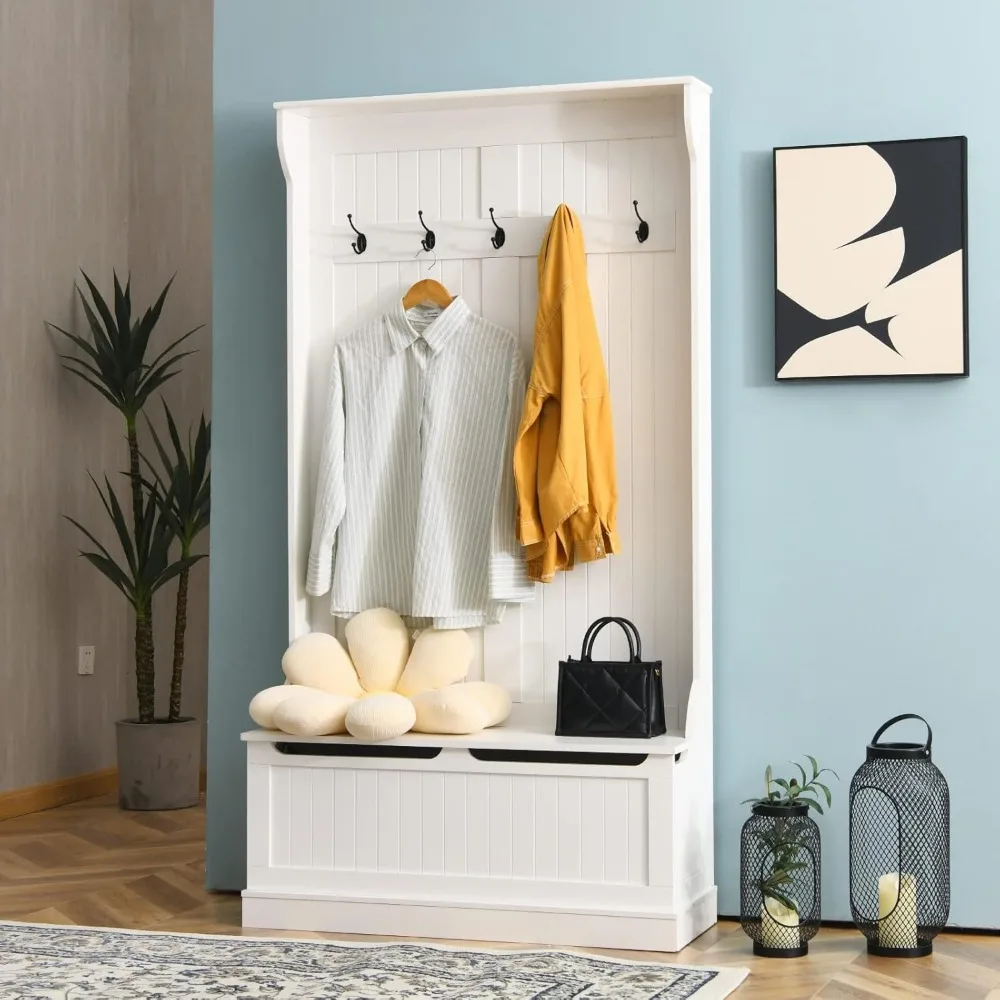
Creative Solutions: Custom and DIY Bench Ideas
When standard options don’t perfectly fit your space constraints, custom and DIY approaches offer tailored solutions:
Simple DIY Bench Projects:
– A basic floating bench can be created using a solid wood board (8-10 inches/20-25 cm deep) mounted to wall studs with heavy-duty brackets
– Repurpose an old dining bench by adding under-seat storage baskets
– Convert a wooden crate to a bench by adding a cushioned top and casters for mobility
Repurposing Furniture:
– Transform a low bookcase into a bench by adding a padded seat cushion
– Convert a dresser by removing the top drawers and creating a seating niche
– Repurpose a kitchen cabinet as a bench base with added cushioning
Custom Building Considerations:
– For unusual architectural features like sloped walls or uneven floors, custom-built options allow perfect integration
– Measure and account for heating vents, electrical outlets, and other permanent features
– Consider modular components that can be reconfigured if needed
Space-Saving DIY Features:
– Add hooks to the underside of a floating bench for bag storage
– Install slim vertical dividers to create shoe compartments
– Incorporate charging stations for electronics within bench storage
For spaces with unusual configurations like angled walls or tight corners, our corner entryway bench collection offers specialized solutions designed to maximize these challenging areas with pre-made options that might inspire your custom approach.
Selecting Ready-Made Benches: What to Look For
When shopping for manufactured bench solutions, keep these quality and compatibility factors in mind:
Key Quality Indicators:
– Solid joinery with screws rather than just glue
– Smooth drawer operation with proper stops
– Even finish without rough patches
– Sturdy construction that doesn’t wobble when in use
Weight Capacity: Standard entryway benches should support at least 250-300 pounds (113-136 kg). Check manufacturer specifications, especially for wall-mounted options where installation method affects capacity.
Assembly Requirements: Consider whether large components will fit through doorways and around tight corners. Some benches ship fully assembled, while others require considerable assembly but can navigate tight spaces more easily.
Versatility Factors: Look for adjustable components like movable dividers, removable cushions, or modular sections that can be reconfigured as needs change.
Return Policies: Before purchasing, verify the return policy and any restocking fees, particularly for larger pieces that may be costly to ship back if they don’t work in your space.
Where to Find Specialty Small-Space Furniture:
– Stores specializing in apartment furniture often carry slimmer profiles
– Custom furniture makers can create pieces to exact specifications
– Online retailers focusing on small-space solutions offer specialized options
Our small entryway bench collection features carefully selected pieces designed specifically for limited spaces, with emphasis on both functionality and aesthetic appeal.
Coat Rack Shoe Bench, Corner Entryway Bench, Corner Hall Tree, Shoe Bench for Entryway
$313.58 Select options This product has multiple variants. The options may be chosen on the product pageCorner Entryway Bench, Entryway Bench with Cushion, Modern Entryway Bench, Shoe Bench for Entryway
$476.34 Select options This product has multiple variants. The options may be chosen on the product pageEntryway Bench with Cushion, Small Entryway Bench
$466.79 Select options This product has multiple variants. The options may be chosen on the product page- Price range: $785.40 through $897.63 Select options This product has multiple variants. The options may be chosen on the product page
Entryway Bench with Storage, Shoe Bench for Entryway
$487.70 Select options This product has multiple variants. The options may be chosen on the product pageFarmhouse Entryway Bench, Narrow Entryway Bench, Shoe Bench for Entryway, Shoe Shelf Bench
$482.78 Select options This product has multiple variants. The options may be chosen on the product page
Accessorizing Your Bench for Enhanced Functionality
The right accessories can dramatically enhance your bench’s utility while maintaining a cohesive look:
Cushions and Padding:
– Choose seat cushions 1-2 inches (2.5-5 cm) thick to add comfort without sacrificing too much storage depth
– Select washable covers for easy maintenance in this high-traffic area
– Consider using cushions with ties or non-slip backing to prevent shifting
Baskets and Containers:
– Use consistent basket styles for visual cohesion
– Select containers that maximize your specific storage dimensions
– Consider clear containers for items you need to locate quickly
Wall Organization:
– Install hooks at approximately 60 inches (152 cm) above the bench for coats
– Add a small shelf 12-15 inches (30-38 cm) above the bench surface for keys and mail
– Mount a mirror to create the illusion of more space while serving practical needs
Lighting Integration:
– Install wall sconces beside or above the bench for improved visibility
– Consider motion-sensor options for convenience when entering with full hands
– Use lighting that complements your bench style for design cohesion
Small-Scale Decor:
– Add personality with a small plant, framed photo, or seasonal decoration
– Keep decorative elements proportional to the bench size
– Rotate accessories seasonally to keep the space fresh
These thoughtful additions transform basic benches with hidden storage into comprehensive entryway solutions. Remember that in small spaces, each accessory should earn its place by providing both function and beauty—items serving double-duty are especially valuable.
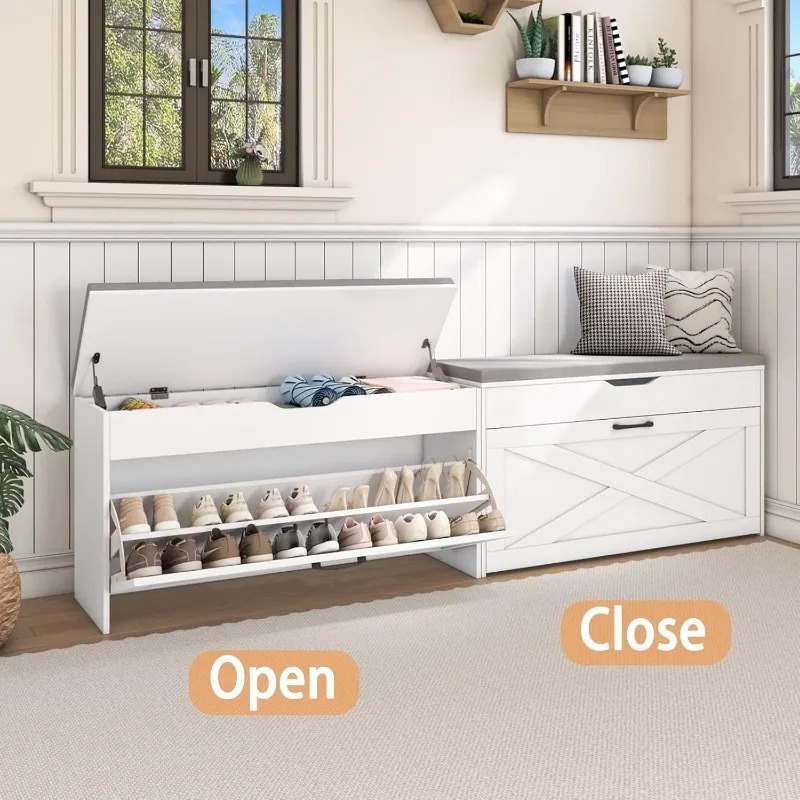
Real-World Examples: Compact Entryway Bench Success Stories
These real-world applications demonstrate how thoughtful bench selection transforms challenging spaces:
Tiny Urban Apartment: In a 450-square-foot studio apartment with a 3-foot wide entrance, a wall-mounted floating bench measuring 28 inches (71 cm) wide by 10 inches (25 cm) deep created a dedicated entry zone without impeding the door. The homeowner installed hooks above and added slim baskets underneath for shoe storage, effectively creating an entryway where none existed before.
Narrow Hallway Solution: A family with a 42-inch (107 cm) wide hallway opted for an ultra-slim bench just 8 inches (20 cm) deep with built-in shoe cubbies. This allowed comfortable passage while still providing essential storage and a spot to sit. The narrow profile maintained traffic flow while containing clutter.
Awkward Corner Transformation: Rather than leaving an awkward L-shaped corner unused, one homeowner installed a custom corner bench that followed the walls’ contours. This solution reclaimed previously wasted space, creating storage for sports equipment and a convenient spot to transition from outdoors.
Multi-Family Solution: Parents with young children implemented a bench with separate cubbies labeled for each family member. At just 36 inches (91 cm) wide, this compact solution allowed each person to have designated storage while maintaining a clean, organized entryway.
Rental-Friendly Options: A renter unable to mount items to walls selected a freestanding hall tree bench combination with a slim footprint. The vertical design maximized storage capacity while respecting the property’s no-holes policy.
These examples demonstrate the principles behind smart entryway storage seating solutions that can be adapted to virtually any space constraint, proving that even the most challenging entryways can be transformed with the right approach.
Conclusion: Making the Most of Your Entryway, Regardless of Size
Even the smallest entryway can become a functional, beautiful transition space with a thoughtfully selected bench. By prioritizing your specific spatial constraints and daily needs, you can find or create a solution that transforms this often overlooked area into one of your home’s most useful spaces.
Remember that successful small-space design requires careful consideration of measurements, functionality, style, and strategic placement. Taking time to plan properly before purchasing ensures your bench will serve as both a practical organizer and welcoming first impression of your home.
The impact of a well-chosen entryway bench extends far beyond its physical footprint. Studies suggest that organized entryways can save the average person up to 15 minutes daily in searching for frequently used items—a small change with significant daily benefits.
With the ideas and approaches outlined here, your small entryway can overcome its spatial limitations to become a space that enhances your daily routine and welcomes you home in style.

